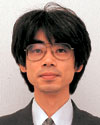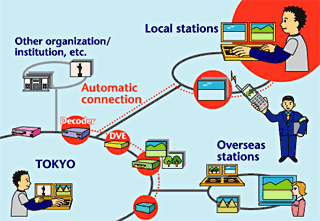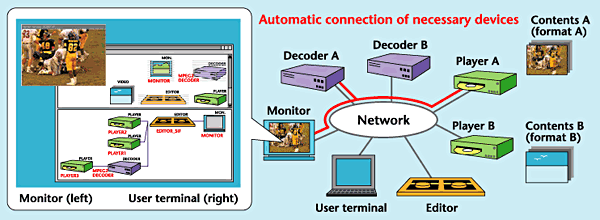|
Network
Plug & Play System for
Broadcasting Station
 |
Yutaka
Kaneko,
Advanced
Audio
and
Video
Coding |
I joined NHK
in 1990 and
have been with
NHK Science
and Technical
Research Laboratories
since 1994.
I have studied
motion estimation
algorithms and
scene description
languages, whose
goal is generation
of TV programming
through the
use of object-based
visual coding.
My recent research
interests include
an advanced
broadcasting
station system
for distributed
processing over
a network. This
research 's
aim is to create
a TV program
production environment
where a program
producer can
easily make
use of contents
and equipment
available on
the network.
The video player
system is our
first experimental
prototype. |
 |
 |
| Figure
1: Network
plug &
play system
for broadcasting
station |
The
rapid advancement
of network technology
is driving the movement
to connect devices
and appliances in
the home and business
environments to
a network, thereby
improving their
functionality and
operability. The
broadcasting equipment
in broadcasting
stations must also
be enhanced in terms
of its network compatibility.
However, broadcasting
station devices
have various signal
formats, which limits
the number of signal
formats that can
be handled by an
individual device.
Because of this,
before such a variety
of devices can be
connected to a network,
the user must confirm
the devices' compatibility
with the signal
format or convert
the format if necessary.
We are studying
a new broadcasting
station system that
will automatically
connect the devices
necessary to deliver
a specific service
or functionality,
this enabling a
user without special
technical knowledge
to freely use the
system. We call
this system a network
plug amp; play system
for a broadcasting
station, since any
equipment installed
on the network can
be made available
for use anywhere
on the network.
Figure
1 shows a broadcasting
station system structure
based on this idea.
Even though the
devices are installed
in different locations,
the system makes
feasible operations
such as program
production and distribution.
New ways of program
production, such
as joint production
by multiple broadcasting
stations or production
using equipment
located at other
broadcasting stations,
will also be possible.
To achieve this
network plug & play
system, a new piece
of middleware was
developed. This
middleware ensures
connections among
devices and data
readout, and allows
a user to employ
devices on the network
without being concerned
about differences
in hardware or video
material signal
format.
We constructed a
prototype distributed
processing video
player system as
an application example
of this middleware
(Figure 2). This
system is capable
of automatically
connecting the equipment
to play back video,
such as servers,
VCRs, and decoders;
the user only has
to select, through
a simple interface
on the user's terminal,
the input video
material and the
output monitor.
In the future, we
will develop a distributed
processing editing
system that will
freely combine devices
on a network to
edit and process
video contents and
develop practical
middleware.
 |

Figure
2: Video player system for distributed processing |
|
|

